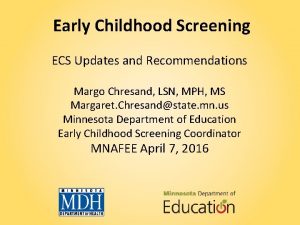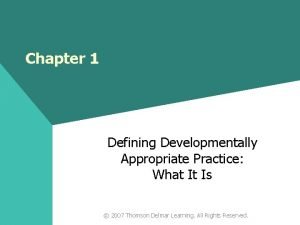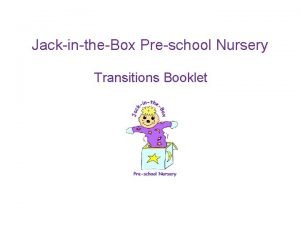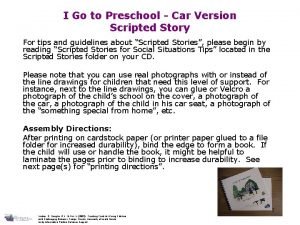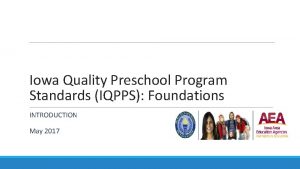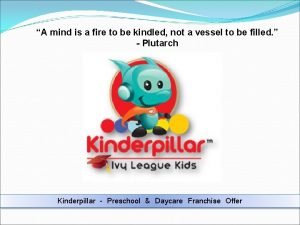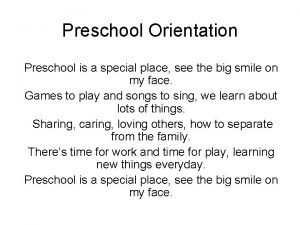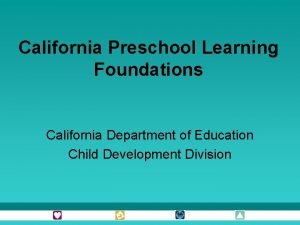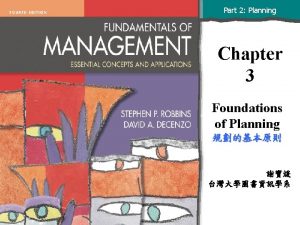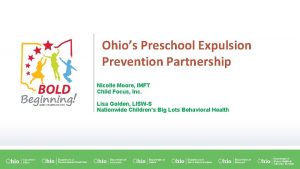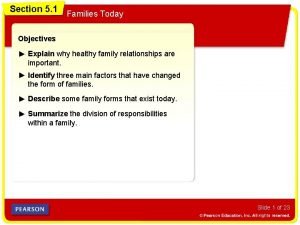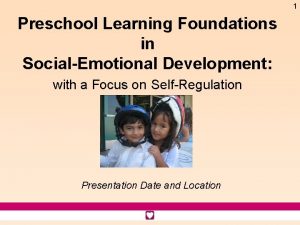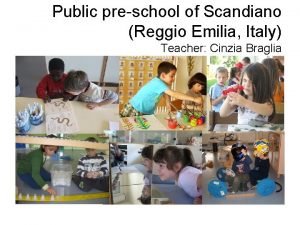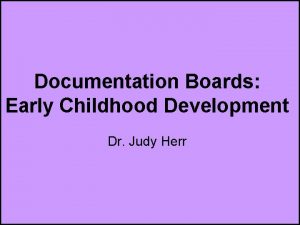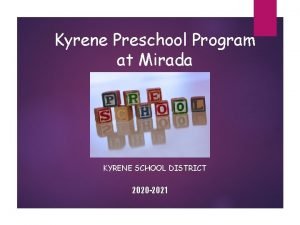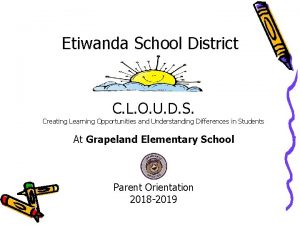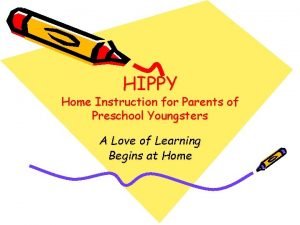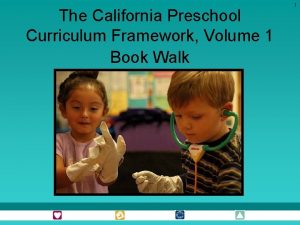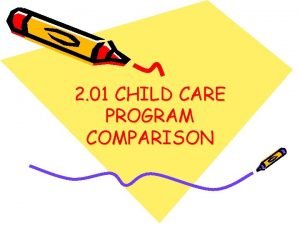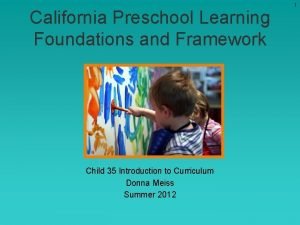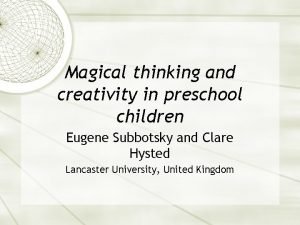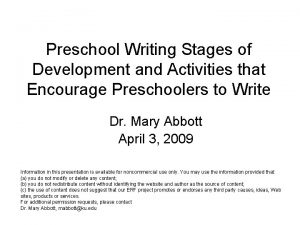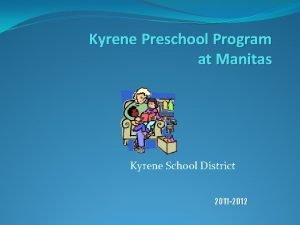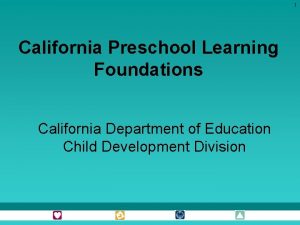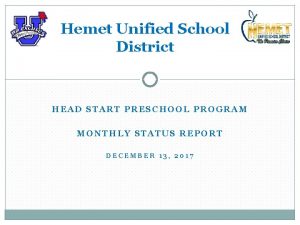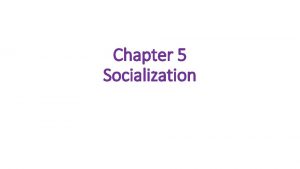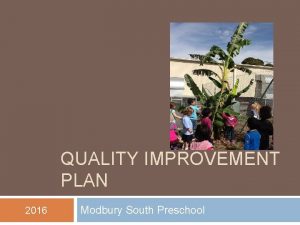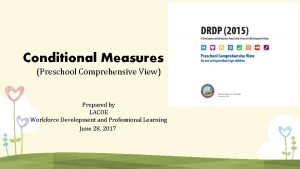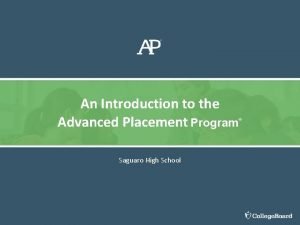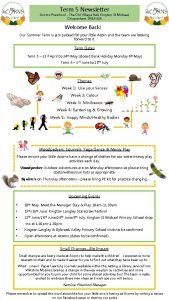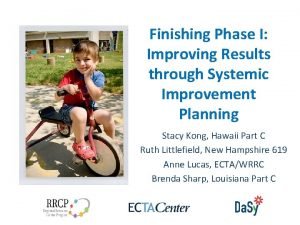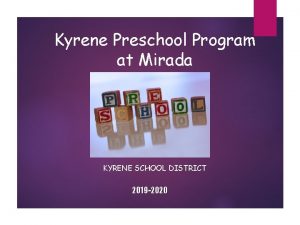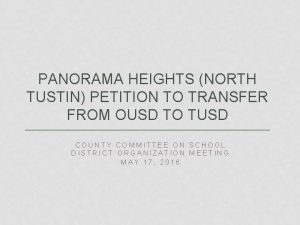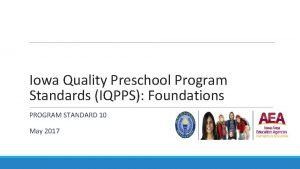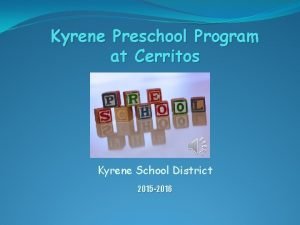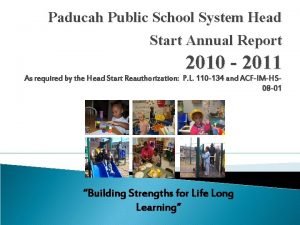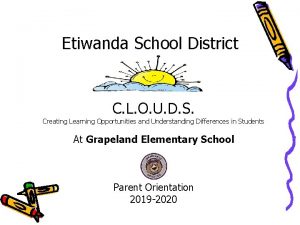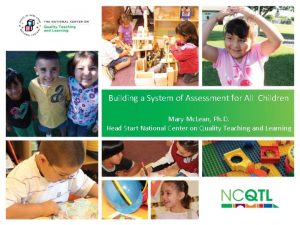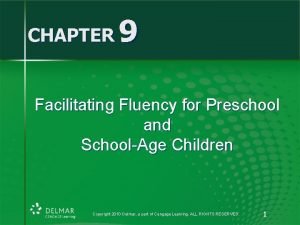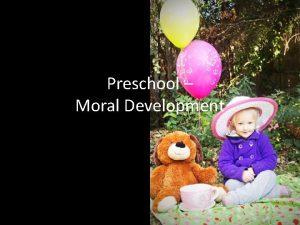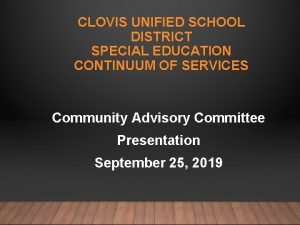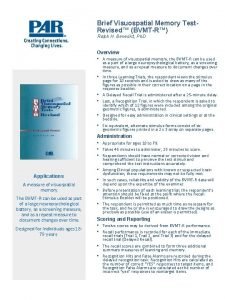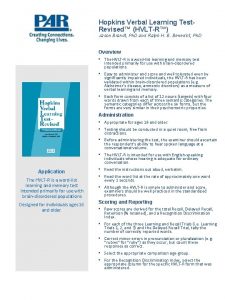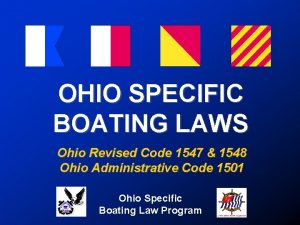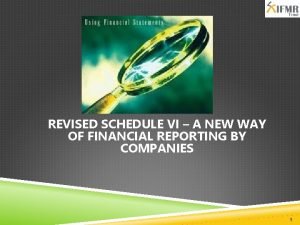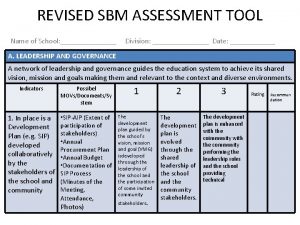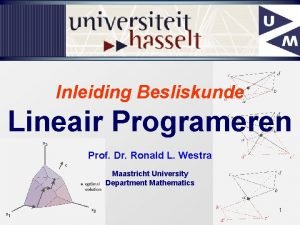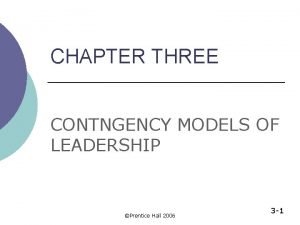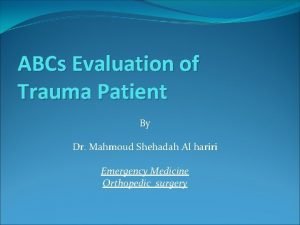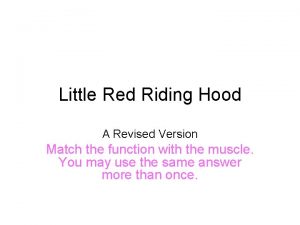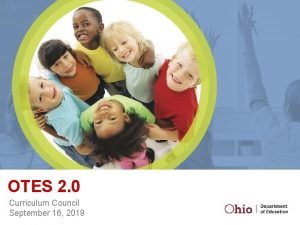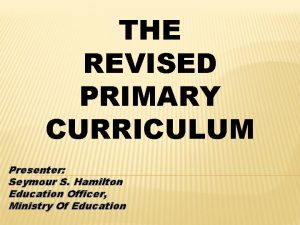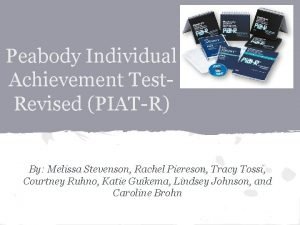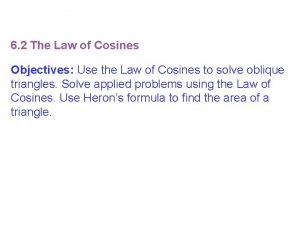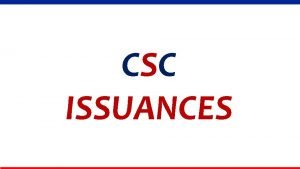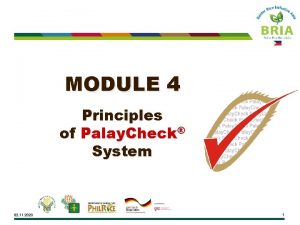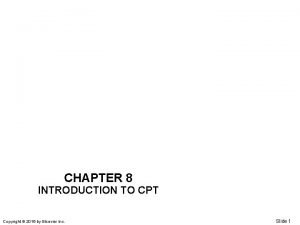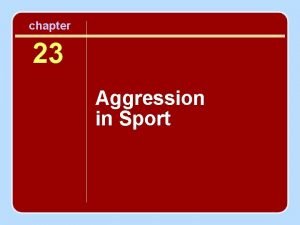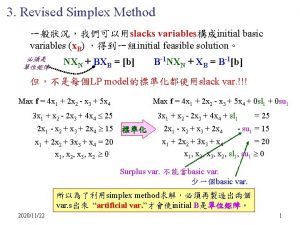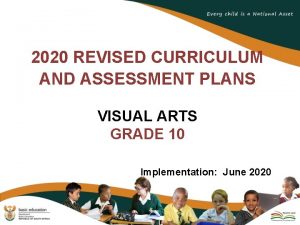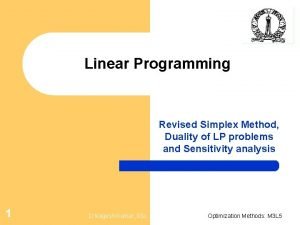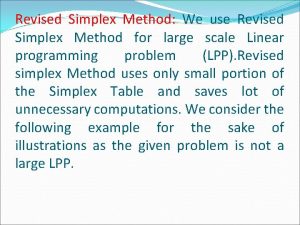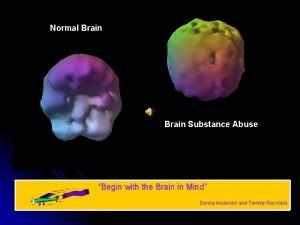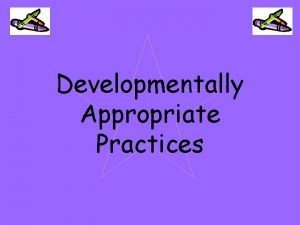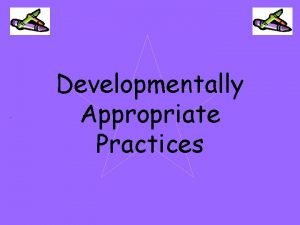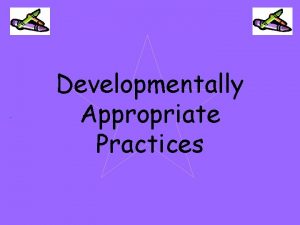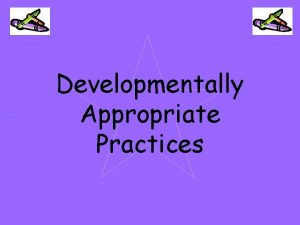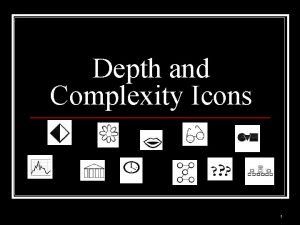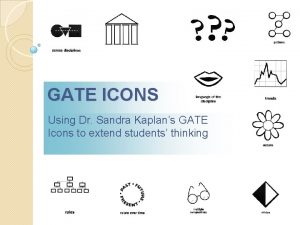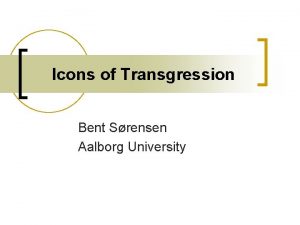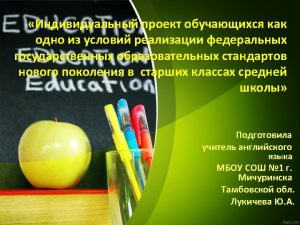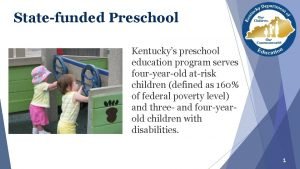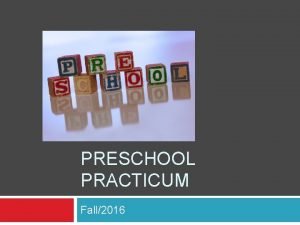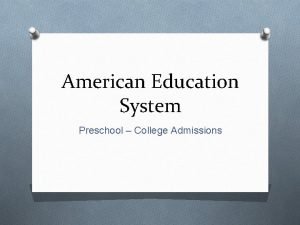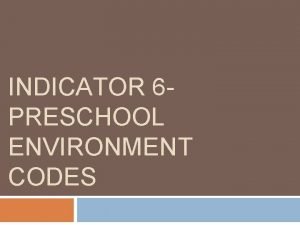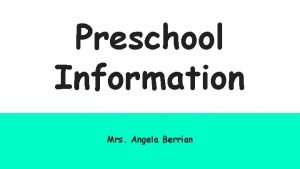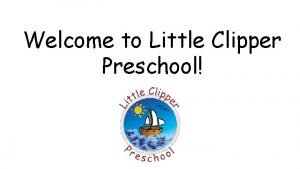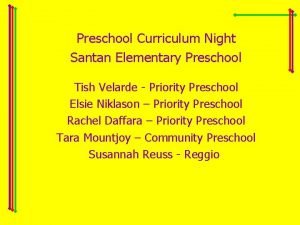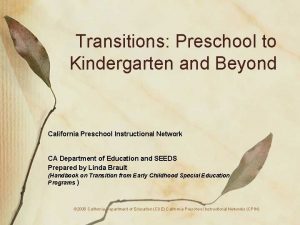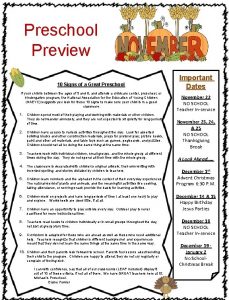Preschool Appropriate Practices Revised 08172015 Icons Several icons






























































































- Slides: 94

Preschool Appropriate Practices Revised 08/17/2015

Icons Several icons are used throughout this course as a visual reference. This icon represents a new topic in the text. This is a visual cue for you to answer any questions about the previous section before moving along to the next one. This icon is used to identify an exercise that involves in-class practices and feedback. This icon is used to identify a specially designed activity that requires active class participation. This icon is used to identify a section that is accompanied by a video. Preschool Appropriate Practices 2

Icons This icon is used to identify the use of an overhead related to the material in this section. This icon is used to identify a key point in the material. This icon is used to identify an online resource. You will need a computer with an internet connection to view these resources. This icon is used to identify an exercise that involves a role-playing scenario. Preschool Appropriate Practices 3

Module 1: Introduction Learning Objectives: • Participants will identify how developmentally appropriate practice applies to children between the ages of 3 -5 years old. • Participants will demonstrate how to apply developmentally appropriate practice for young children in the learning environment. TG - 2 Preschool Appropriate Practices

DAP – How It Applies Young children need: • Variety of experiences • Lots of play opportunities • Socialization • Exposure to rich language experiences TG - 6 Preschool Appropriate Practices 5

Key Point Caregivers should plan and prepare experiences that are fun, stimulating and offer handson opportunities for learning that are challenging and achievable. TG - 7 Preschool Appropriate Practices 6

Key Point Language development is one of the most important aspects of a child’s learning during the ages of 3 -5 years. TG - 8 Preschool Appropriate Practices 7

Module 1 Summary Module 1 introduced: • How developmentally appropriate practice is applied to young children • How to apply developmentally appropriate practice in the learning environment TG - 9 Preschool Appropriate Practices

Module 2: Stages of Development for Young Children Learning Objectives: • Participants will describe each of Piaget’s and Erikson’s theories and how they apply to the development of young children. • Participants will recognize milestones for young children under each developmental domain. • Participants will identify developmental alerts for children ages 35. TG - 10 Preschool Appropriate Practices

A Quick Review of Piaget and Erikson • Jean Piaget – Four Stages of Cognitive Development • Erikson – Eight Conflicts of Social and Emotional Development TG - 11 Preschool Appropriate Practices 10

Jean Piaget: The Four Stages of Cognitive Development • • Sensorimotor – 0 -2 years old Preoperational – 2 -7 years old Concrete-Operational – 7 -11 years old Formal Operations – 11 years old and older TG - 12 Preschool Appropriate Practices 11

Key Point According to Piaget, the Preoperational stage is from ages 2 -7 and is most relevant to young children. During this stage, young children learn about their world through their actions. TG - 13 Preschool Appropriate Practices 12

Key Point Piaget’s theory explains how children interact with their environment to construct knowledge. TG - 13 Preschool Appropriate Practices 13

Erikson and the Eight Conflicts in Emotional Development Erikson developed theory that emotional development occurs through eight stages in a person’s lifetime. He proposes that individuals must go through each of the eight stages in a sequential order. TG - 14 Preschool Appropriate Practices 14

Erikson - Eight Conflicts in Emotional Development Age Conflict Meaning Infant Trust vs. Mistrust Trust is developed over time by providing an infant with a consistent, comforting environment. When needs are met, trust is established. Trust builds an emotional foundation. A lack of trust can result in poor emotional stability. Toddler Autonomy vs. Shame and Doubt Toddlers need to explore their own bodies and environment in order to become confident about themselves. When autonomy is allowed, a person can become comfortable with his/her choices. A lack of autonomy can result in a feeling of shame or insecurity. Initiative vs. Guilt Four- or five-year olds begin to develop an interest in exploring beyond themselves. Children who are not allowed to pursue their natural curiosity will be prone to feel guilt for their actions. When initiative is encouraged, a person experiments within one’s environment. A lack of encouragement for initiative can result in a feeling of guilt for acting on one’s natural curiosity. Between the ages of 6 to 12, children show the ability to develop competencies. Children who are inhibited in developing these skills and abilities will experience inferiority. When children experience success, they attain a sense of adequacy and pride. A lack of industry can result in a feeling of low self-worth. Preschool Grade School Industry vs. Inferiority High School Identity vs. Role Confusion Between the ages of 12 to 18, children are attempting to define who they are and where they are going. When children are given the opportunity to develop their own ideas and opinions, they can form their own identity. A lack of identity will lead to confusion about who they are. Early Adult Intimacy vs. Isolation Between the ages of 18 to 35, young adults are exploring the development of relationships. Young adults need the opportunity to develop close relationships with family, friends, and partners. A lack of intimate relationships can lead to individuals feeling isolated and alone. Middle Adult Generativity vs. Stagnation Between the ages of 35 to 64, adults are seeking a sense of accomplishment in life through family and career. Adults need to see progress in their careers or success in their contributions to society. A lack of accomplishment often leads to feelings of resentment and regret. Late Adult Integrity vs. Despair After the age of 65, adults seek meaning in their lives. Adults are reflecting on their accomplishments and fulfillment in life. A lack of achievement may lead to despair in the final years. Preschool Appropriate Practices TG – 14 15

Key Point Erikson’s theory on social development states that children at this age must be nurtured while they develop an interest in exploring beyond themselves. TG - 16 Preschool Appropriate Practices 16

Florida has developed learning standards for children birth through age five. View them at the Florida Department of Education Office of Early Learning. http: //www. floridaearlylearning. com/parents/parent_resource s/floridas_early_learning_and_development_standards_birth _to_five. aspx TG - 17 Preschool Appropriate Practices 17

Developmental Domains for Young Children • Physical Development • Social and Emotional • Language and Communication • Cognitive Development and General Knowledge • Approaches to Learning Preschool Appropriate Practices TG - 18 18

Physical Development in Young Children • Growing taller and leaner than toddlers • Smaller appetite • Weight gain • Height gain • Lower center of balance • Improved spatial ability TG - 18 Preschool Appropriate Practices 19

Gross Motor Skills • Walking • Running • Jumping • Climbing • Throwing TG - 19 Preschool Appropriate Practices 20

Fine Motor Skills • Coloring • Modeling • Cutting • Stringing • Self-help skills TG - 19 Preschool Appropriate Practices 21

Social and Emotional Development • Begin to understand rules and limits. • Learn how to interact socially with their peers and adults in various ways. • Begin to imitate the actions of both adults and other children. • Begin to explore different actions in an attempt to understand what types of behaviors are acceptable. • Begin to adapt to different settings and their conversational skills are beginning to develop. • Ask many questions while they try to make sense of various situations. TG - 20 Preschool Appropriate Practices 22

Language and Communication • Improvement in understanding of speech. • Children at this age often make language mistakes, for example saying, “I goed” instead of “I went”; or applying one speech rule to all words, for example “toothes” instead of “teeth” and “foots” instead of “feet. ” • Be sure to encourage correct language usage. Instead of telling a child they are wrong, model the appropriate language back to them. TG - 20 Preschool Appropriate Practices 23

Written Language • Understand print. • Distinguish writing from non-writing. • Recognize letters and words. • Write letters followed by mock letters. • Recognize how words and sentences are organized. TG - 21 Preschool Appropriate Practices 24

Cognitive Development and General Knowledge • The word order of subjects and verbs. • Words to describe locations. • Opposite words such as “more” vs. “less”. • Around 4 years old, they will begin to understand similarities in words such as “cup” vs. “glass” and TG - 21 “bike” vs. “bicycle. ” Preschool Appropriate Practices 25

Approaches to Learning • Creativity and Inventiveness • Eagerness and Curiosity • Persistence • Planning and Reflection TG - 22 Preschool Appropriate Practices 26

Developmental Alerts • While all children are not expected to develop at the same rate, there are some warning signs that may indicate that a child has a developmental delay. • These warning signs are described as behaviors or activities that a child is not able to perform by a certain age. • If you think that a child may be exhibiting warning signs of a developmental delay, inform your director of your concerns immediately. TG - 25 Preschool Appropriate Practices 27

Module 2 Summary Module 2 introduced: • The theories of Piaget and Erikson • The milestones of young children in each of the developmental domains • Developmental alerts for children ages 3 -5 TG - 27 Preschool Appropriate Practices

Module 3: Enhanced Development and Learning Objectives: • Participants will create activities and experiences designed to enhance the learning opportunities provided through play. • Participants will define play and identify reasons for play. • Participants will identify the stages of play development. • Participants will define the concepts of active learning and active listening. TG - 28 Preschool Appropriate Practices

Description and Reasons for Play 1. Play provides pleasure to the player 2. Play focuses more on the player’s enjoyment of the process than the acquisition of some particular product 3. Play is voluntary and freely chosen by the player 4. Play involves active engagement by the player TG - 30 Preschool Appropriate Practices 30

Key Point Children’s language, physical and social development improves through play, as well as their problem-solving skills. TG - 30 Preschool Appropriate Practices 31

Activity: Stages of Play • What are some examples of play you have seen in young children? • Do young children ever engage in cooperative play? • Do young children ever engage in solitary play? More information regarding the stages of play can be found at the following links: http: //www. youtube. com/watch? v=-Gg. OCQx 9 w 8 I&feature=search http: //www. youtube. com/watch? v=nh. F 6 E 7 z. Hq. WI&feature=search TG - 32 Preschool Appropriate Practices 32

Activity: Describing Apples TG - 33 Preschool Appropriate Practices 33

Activity: Describing Apples TG - 33 Preschool Appropriate Practices 34

• Can you tell by this activity how children and adults learn? • How will this affect the way you set up your classroom and the activities you provide? • How can the special needs of children affect learning? For example, what if you could not see the apple? How else might you learn what an apple is? TG - 34 Preschool Appropriate Practices 35

Key Point Manipulation of materials by itself does not constitute active learning. Children must have choices, use language, and be supported by adults. TG - 35 Preschool Appropriate Practices 36

Creative Curriculum • • • Art area Block area Computer center Cooking area House center Library Music and movement Outdoors Sand water Table toys TG - 36 Preschool Appropriate Practices 37

Key Point It is important to have a wide variety of learning centers that offer diverse, challenging and achievable opportunities for play. TG - 36 Preschool Appropriate Practices 38

Additional Resources: The Florida Department of Education Office of Early Learning has developed curriculum resources for both the School Readiness and VPK Programs: http: //www. floridaearlylearning. com/providers/provider_r esources/school_readiness_curriculum. aspx http: //www. floridaearlylearning. com/providers/provider_r esources/vpk_curriculum. aspx TG - 36 Preschool Appropriate Practices 39

Active Listening • Process of taking an active role in hearing and responding to what children have to say. • Uses open-ended questions to stimulate a child’s thinking. • Be sure to wait for a response from the child. TG - 37 Preschool Appropriate Practices 40

Key Point Using active listening with children encourages them to talk. TG - 37 Preschool Appropriate Practices 41

Shelley Lovett from http: //childcareland. com/ has an informative video about descriptive praise on You. Tube: http: //www. youtube. com/watch? v=z 1 t 2 p. M 7 m. Vs&feature=player_embedded TG - 37 Preschool Appropriate Practices 42

Teacher Interaction You should be actively identifying connections between the learning activities you create and the areas of learning you are stimulating in children. TG - 39 Preschool Appropriate Practices 43

Remember back in the Child Growth and Development course, information regarding lesson planning was discussed. For more information regarding curriculum, visit the Florida Department of Education website: http: //www. floridaearlylearning. com/providers/provider_ menu/professional_development_and_training_resourc es/vpk_professional_development_and_teacher_resour ces. aspx TG - 40 Preschool Appropriate Practices 44

Module 3 Summary Module 3 introduced: • The concept of enhancing learning opportunities through play • The description and reasons for play • The stages of play development • The concepts of active learning and active listening TG - 41 Preschool Appropriate Practices

Module 4: Quality Learning Environments Learning Objectives: • Participants will identify the elements of a quality learning environment. • Participants will recognize the methods used to plan learning centers and create effective traffic flow. • Participants will identify developmentally appropriate toys and materials for young children. TG - 42 Preschool Appropriate Practices

Key Point Developmentally appropriate environments must be safe, comfortable and support children’s play through hands-on learning experiences. TG - 43 Preschool Appropriate Practices 47

Learning Centers TG - 45 Preschool Appropriate Practices 48

Activity: Evaluating Learning Centers TG - 46 Preschool Appropriate Practices 49

Activity: Evaluating Learning Centers TG - 46 Preschool Appropriate Practices 50

Room Arrangement TG - 48 Preschool Appropriate Practices 51

Key Point When arranging your classroom, you need to first plan for safety, but also find a balance that ensures children are comfortable and feel welcome. TG - 48 Preschool Appropriate Practices 52

Video: “Room Arrangement” TG - 49 Preschool Appropriate Practices 53

Developmentally Appropriate Toys and Activities TG - 50 Preschool Appropriate Practices 54

Key Point Using age-appropriate toys and materials encourages children to engage in hands-on learning. Be sure that all toys and materials are clean and safe. TG - 51 Preschool Appropriate Practices 55

Activity – Where Do Learning Materials Belong? TG - 52 Preschool Appropriate Practices 56

Daily Routines TG - 53 Preschool Appropriate Practices 57

Key Point Successful transitions are the key to effectively carrying out your daily routine and maintaining order. TG - 53 Preschool Appropriate Practices 58

Module 4 Summary Module 4 introduced: • The elements of a quality learning environment • How to plan learning centers and create effective traffic flow • Developmentally appropriate toys and materials TG - 55 Preschool Appropriate Practices

Module 5: Positive Guidance Strategies Learning Objectives: • Participants will identify methods for preventing difficult and challenging behaviors. • Participants will recognize the characteristics of a role model for good behavior in the classroom. • Participants will define appropriate disciplinary practices that comply with state and federal law. TG - 56 Preschool Appropriate Practices

Positive Guidance Strategies • What are some of the positive behaviors that we see in young children on a day-to-day basis? • What are some negative behaviors that are seen in young children? • What are some of the things that may cause children to behave this way? TG - 58 Preschool Appropriate Practices 61

Promoting Positive Behavior TG - 59 Preschool Appropriate Practices 62

Promoting Positive Behavior TG - 59 Preschool Appropriate Practices 63

Key Point Ensure that children understand what is expected of them. Children cannot be expected to adhere to unclear rules and expectations about conduct and behavior. TG - 60 Preschool Appropriate Practices 64

Creating Developmentally Appropriate Classroom Rules TG - 61 Preschool Appropriate Practices 65

Key Point Classroom rules are the foundation of a stable learning environment. Reinforce the classroom rules whenever possible to ensure that all children fully understand them. TG - 61 Preschool Appropriate Practices 66

Be a Role Model TG - 62 Preschool Appropriate Practices 67

Warning Signs TG - 63 Preschool Appropriate Practices 68

Intervention Techniques TG - 64 Preschool Appropriate Practices 69

Key Point When intervening with children, you must remember to maintain the child’s self-esteem and set a good example by controlling your anger. TG - 65 Preschool Appropriate Practices 70

Redirection Can you describe some other ways that you can distract children engaged in unwanted behaviors and redirect their attention? • Use favorite toys to grab children’s attention • Flick the classroom lights on and off • Turn on a radio or sing a song • Transition into another activity • Ask the child to help you with a task Can you describe some inappropriate ways of dealing with unwanted behaviors? • Yelling, raising your voice at children • Throwing objects • Putting children in time out • Using threats • Spanking/physical punishment • Humiliation Preschool Appropriate Practices TG - 66 71

Bullying TG - 67 Preschool Appropriate Practices 72

Key Point Bullying can cause emotional damage to children when they are bullied either physically or emotionally. There should be a no tolerance policy for bullying in your program. TG - 67 Preschool Appropriate Practices 73

The U. S. Health Resources and Services Administration has a great website about bullying at: http: //www. stopbullying. gov/ This website is a great resource for both children and adults in the child care field. (Keyword: bullying) TG - 67 Preschool Appropriate Practices 74

Dr. Becky Bailey is an expert in childhood education and developmental psychology. She has developed a comprehensive classroom management program titled Conscious Discipline®. This program is designed to help childcare professionals learn relationship skills that encourage good disciplinary practices in the home, school and community. You can learn more about the Conscious Discipline® program at: http: //consciousdiscipline. com/about/dr_becky_bailey. asp TG - 68 Preschool Appropriate Practices 75

Second Step is a violence prevention program created by Committee for Children, a nonprofit organization. The program is available for preview and purchase through their Client Support Services at info@children. org or 800 -6344449, ext. 200. You can visit their website at: http: //www. cfchildren. org/ TG - 68 Preschool Appropriate Practices 76

Positive Behavioral Support is a program designed to eliminate challenging behaviors in children and encourage positive and desirable behaviors in their place. You can learn more about this program by visiting the website at: http: //www. nasponline. org/resources/factsheets/pbs_fs. aspx TG - 68 Preschool Appropriate Practices 77

Tvoparents. com has an informative video discussing guidance techniques with young children on You. Tube: http: //www. youtube. com/watch? v=hc 1 RUDc. Sjh. U TG - 69 Preschool Appropriate Practices 78

Module 5 Summary Module 5 introduced: • Methods for preventing difficult and challenging behaviors • How to be a role model of good behavior in the classroom • Appropriate disciplinary practices and compliance with state and federal law TG - 70 Preschool Appropriate Practices

Module 6: Create a Caring Community in the Classroom Learning Objectives: • Participants will identify the benefits of building a classroom community. • Participants will describe methods for encouraging positive social and emotional development in young children. • Participants will define techniques for fostering empathy and creating awareness and a sense of belonging. TG - 71 Preschool Appropriate Practices

Key Point The development of positive social and emotional skills at this age leads to greater success in all areas later in life. TG - 72 Preschool Appropriate Practices 81

Key Point Encouraging children to stay engaged in play helps them learn appropriate ways to maintain social interactions and overcome conflict. TG - 73 Preschool Appropriate Practices 82

Nurturing Emotional Development TG - 74 Preschool Appropriate Practices 83

Key Point Emotional development occurs in young children when they are able to identify, understand express their feelings. TG - 74 Preschool Appropriate Practices 84

Key Point Be a role model of kindness and empathy. Set an example of how to show kindness to the people around you. TG - 75 Preschool Appropriate Practices 85

Key Point Children learn empathy and caring by becoming a part of a community in your classroom. TG - 77 Preschool Appropriate Practices 86

Parents. tv has a clip from their segment “Teachable Moments” about fostering empathy in young children on You. Tube: http: //www. youtube. com/watch? v=TL 76 Nh. S 77 hs TG - 77 Preschool Appropriate Practices 87

Cultural/Social Appropriateness TG - 78 Preschool Appropriate Practices 88

Children with Special Needs Down Syndrome According to the National Institute of Health, “Down syndrome is the most frequent genetic cause of mild to moderate intellectual and developmental disabilities and associated medical problems and occurs in one out of 800 live births, in all races and economic groups. ” http: //www. ncbi. nlm. nih. gov/pubmedhealth/PMH 0001992/ TG - 79 Preschool Appropriate Practices 89

For more information about Down Syndrome, visit the following websites: National Institute of Health: http: //www. ncbi. nlm. nih. gov/pubmedhealth/PMH 0001992/ National Down Syndrome Society: http: //www. ndss. org/ TG - 80 Preschool Appropriate Practices 90

Children with Special Needs Autism According to the National Institute of Neurological Disorders and Stroke website, “Autism spectrum disorder (ASD) is a range of complex neurodevelopment disorders, characterized by social impairments, communication difficulties, and restricted, repetitive, and stereotyped patterns of behavior. ” TG - 80 Preschool Appropriate Practices 91

For more information about autism you can visit the National Institute of Neurological Disorders and Stroke website: http: //www. ninds. nih. gov/disorders/autism/detail_autism. htm TG - 80 Preschool Appropriate Practices 92

Key Point The development of emotional security in children at this age begins with a nurturing, predictable and caring relationship with parents and caregivers. TG - 81 Preschool Appropriate Practices 93

Module 6 Summary Module 6 introduced: • The benefits of building a classroom community • Methods for encouraging positive social and emotional development in young children • Techniques for fostering empathy, creating awareness of others and creating a sense of belonging to a group TG - 83 Preschool Appropriate Practices
 Early childhood screening rochester mn
Early childhood screening rochester mn Developmentally appropriate definition
Developmentally appropriate definition Jack in the box
Jack in the box Hollingworth preschool
Hollingworth preschool Scripted stories for preschool
Scripted stories for preschool Iqpps
Iqpps Objective vs outcome
Objective vs outcome Drdp modified essential view
Drdp modified essential view Kinderpillar preschool
Kinderpillar preschool Preschool westlake
Preschool westlake A special place preschool
A special place preschool Ca preschool foundations
Ca preschool foundations Preschool learning foundations
Preschool learning foundations Preschool to prison pipeline
Preschool to prison pipeline 5-1 changing households
5-1 changing households Preschool learning foundations volume 1
Preschool learning foundations volume 1 Reggio emilia italy preschool
Reggio emilia italy preschool Documentation boards for preschool
Documentation boards for preschool Kyrene preschool
Kyrene preschool Etiwanda clouds
Etiwanda clouds Preschool room arrangement
Preschool room arrangement Hippy home instruction for parents of preschool youngsters
Hippy home instruction for parents of preschool youngsters Preschool framework volume 1
Preschool framework volume 1 Bus stop preschool
Bus stop preschool Hbpc preschool
Hbpc preschool Virginia preschool initiative income guidelines 2020
Virginia preschool initiative income guidelines 2020 Preschool learning foundations math
Preschool learning foundations math Preschool learning foundations volume 1
Preschool learning foundations volume 1 Fantastical thinking definition
Fantastical thinking definition Phases of writing development
Phases of writing development Kyrene school schedule
Kyrene school schedule Preschool learning foundations
Preschool learning foundations Preschool hemet
Preschool hemet Egalia preschool sweden
Egalia preschool sweden Modbury south preschool
Modbury south preschool Drdp (2015 fundamental view)
Drdp (2015 fundamental view) Preschool learning foundations math
Preschool learning foundations math Preschool primary secondary
Preschool primary secondary Saguaro infant care and preschool
Saguaro infant care and preschool June preschool newsletter
June preschool newsletter Preschool infrastructure
Preschool infrastructure Kyrene school district preschool
Kyrene school district preschool Tustin school district map
Tustin school district map Iqpps
Iqpps Kyrene preschool
Kyrene preschool Paducah head start preschool
Paducah head start preschool Clouds etiwanda school district
Clouds etiwanda school district Drdp preschool measures at a glance
Drdp preschool measures at a glance Preschool fluency activities
Preschool fluency activities Preschool prefix
Preschool prefix Preschool moral development
Preschool moral development Clovis adults school program
Clovis adults school program Preschool learning foundations volume 3
Preschool learning foundations volume 3 Christ evangelical lutheran church
Christ evangelical lutheran church Bvmt-r
Bvmt-r 2021 revised curriculum and assessment plans grade 7
2021 revised curriculum and assessment plans grade 7 Hopkins verbal learning test revised
Hopkins verbal learning test revised Revised curriculum 2020
Revised curriculum 2020 Orc expired tags
Orc expired tags Qprofits
Qprofits Egra arata assessment tool
Egra arata assessment tool Revised simplex method
Revised simplex method Revised curriculum 2020
Revised curriculum 2020 2020 revised curriculum and assessment plans
2020 revised curriculum and assessment plans Yukl's multiple linkage model
Yukl's multiple linkage model 2020 revised curriculum and assessment plans
2020 revised curriculum and assessment plans Revised trauma score
Revised trauma score Isa 540 revised
Isa 540 revised Ghg protocol revised
Ghg protocol revised A revised version of little red riding hood
A revised version of little red riding hood Ohio revised code 3319
Ohio revised code 3319 Revised primary curriculum grade 1-3
Revised primary curriculum grade 1-3 2020 revised curriculum and assessment plans
2020 revised curriculum and assessment plans 2020 revised curriculum and assessment plans
2020 revised curriculum and assessment plans Peabody individual achievement test
Peabody individual achievement test Law of cosines sss
Law of cosines sss 2020 revised curriculum and assessment plans grade 7
2020 revised curriculum and assessment plans grade 7 Csc form 33-a revised 2018
Csc form 33-a revised 2018 2020 revised curriculum and assessment plans
2020 revised curriculum and assessment plans What is palaycheck system
What is palaycheck system Isa 315 summary
Isa 315 summary Which cpt symbol is used to convey a revised code
Which cpt symbol is used to convey a revised code 2021 revised curriculum and assessment plans
2021 revised curriculum and assessment plans Revised curriculum 2020
Revised curriculum 2020 Instinct theory in sport
Instinct theory in sport Revised annual teaching plans 2020
Revised annual teaching plans 2020 Simplex method教學
Simplex method教學 2020 revised curriculum and assessment plans
2020 revised curriculum and assessment plans Dual simplex method minimization example
Dual simplex method minimization example 2020 revised curriculum and assessment plans
2020 revised curriculum and assessment plans Revised simplex method
Revised simplex method Fiscal incentives for industrial promotion (revised)-2013
Fiscal incentives for industrial promotion (revised)-2013 Bloom's revised taxonomy
Bloom's revised taxonomy Revised curriculum and assessment plans 2021
Revised curriculum and assessment plans 2021 Taskpat
Taskpat
